What are Mycotoxins & Do Air Purifiers Remove Them from the Air?
The presence of mold inside of your home can lead to more problems than you may think, especially when it comes to the formation of certain species of mold within the indoor space. Mold is a rapidly growing fungus that will spread aggressively throughout a home, or wherever the mold begins its dramatic formation and that will allow for airborne pollutants to be produced and spread in the air. All mold species will reproduce through the releasing of mold spores in the air that will travel throughout the air and attach to surfaces to begin its new surface growth. However, with some mold species such as the ominous black mold and other potentially toxic mold species, other substances will also be produced and released into the air in addition to the mold spores that mold already emits into the air – these toxic substances are what are known as mycotoxins.
If you have ever dealt with the formation and spreading of a toxic mold species in your home such as stachybotrys chartarum (aka black mold) than you may be familiar with the hazardous mycotoxin substance that the mold releases into the air. These mold substances have been said to significantly alter the health of a person upon exposure, as well as the indoor air quality of the impacted environment. What can be done to mitigate these toxic mold substances from the air and how can these mycotoxins effect a person’s health and the environment?
In this article we are going to learn more about mycotoxins and how they are produced from mold that grows in a home, as well as the best ways to filter out and remove these harmful mold substances from the air of your personal indoor environment.
What are Mycotoxins
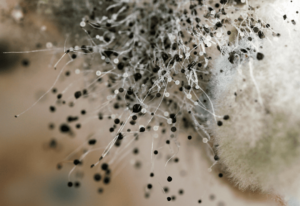 Mold will slowly creep into the inside space of a home and continue its aggressive progression as it will emit mold spores in the air. When it comes to mold, most of the mold species will tend to emit strong moldy odors into the air, as well as mold spores in their pursuit to advance the growth of this mold colony on other surfaces in the home. However, in some instances toxic mold species will find their way into your home and start their hazardous journey within the air space of this environment – and these toxic molds may be known for their production of mycotoxins into the air. Mycotoxins are toxic compounds that are naturally produced by certain types of molds that will be dangerous when it comes to human health, since it has been known for causing disease and death in both humans and animals.
Mold will slowly creep into the inside space of a home and continue its aggressive progression as it will emit mold spores in the air. When it comes to mold, most of the mold species will tend to emit strong moldy odors into the air, as well as mold spores in their pursuit to advance the growth of this mold colony on other surfaces in the home. However, in some instances toxic mold species will find their way into your home and start their hazardous journey within the air space of this environment – and these toxic molds may be known for their production of mycotoxins into the air. Mycotoxins are toxic compounds that are naturally produced by certain types of molds that will be dangerous when it comes to human health, since it has been known for causing disease and death in both humans and animals.
According to the World Health Organization (WHO), there are several hundred different mycotoxins that have been identified, and that have been found to present a concern to human health after exposure to these mycotoxins in the environment. Aflatoxins is a type of mycotoxin that is most poisonous for humans and these specific types of mycotoxins are produced by certain molds such as Aspergillus flavus and Aspergillus parsiticus. As mold begins to develop inside of a home, they will start to consume organic matter wherever humidity and temperature are sufficient and in these optimal conditions, the fungi will proliferate into colonies and allow for mycotoxin levels to become high.
How Does Mold Form
Have you ever come across a wet spot on the surface(s) of your home, such as ceilings, walls, or even flooring that have been caused by accidental water intrusions? Mold is a type of fungal growth that will develop on these wet spots of material around your home, especially in environments where other optimal conditions are present as well. These fungal growths can be found nearly everywhere due to their versatile nature that allows them to grow in both indoor and outdoor environments. Mold will grow and eat away at organic materials found throughout your home like walls, floors, and other material that will allow for the mold to thrive inside this indoor space, and eventually will promote the production of mold spores into the air.
When it comes to detecting mold that is forming and growing inside of your home, some of the first known signs will be a detectable smell and signs of water damage or discoloration on the surfaces in the indoor space. Typically, mold spores will grow and colonize within 24 hours to 10 days after the introduction of the mold on the surface.
What are Mold Spores
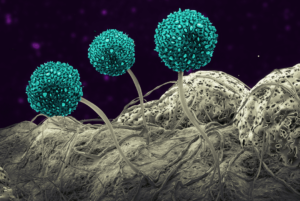 As we have discussed prior, when mold is forming and growing within the indoor space of a home it will produce and emit mold spores into the air that will attach to the various surfaces throughout this space. Mold spores are tiny structures produced by molds for the purpose of reproduction, these “seeds” will easily float in the air and attach to the surfaces for continued growth. These spores typically range in size from three to 40 microns in size, which is so small that it is less than half the width of a piece of human hair. The small size of these spores may be cause for concern, especially when it comes to occupant exposure, as these spores can be easily ingested/inhaled into the human body and lead to adverse health effects. These spores when they are ingested/inhaled can enter into the respiratory system and begin the start of symptoms such as allergic reactions and upper respiratory ailments.
As we have discussed prior, when mold is forming and growing within the indoor space of a home it will produce and emit mold spores into the air that will attach to the various surfaces throughout this space. Mold spores are tiny structures produced by molds for the purpose of reproduction, these “seeds” will easily float in the air and attach to the surfaces for continued growth. These spores typically range in size from three to 40 microns in size, which is so small that it is less than half the width of a piece of human hair. The small size of these spores may be cause for concern, especially when it comes to occupant exposure, as these spores can be easily ingested/inhaled into the human body and lead to adverse health effects. These spores when they are ingested/inhaled can enter into the respiratory system and begin the start of symptoms such as allergic reactions and upper respiratory ailments.
These mold spores will drift throughout the air, and eventually will come into contact with different surfaces in the home and begin its growth phase. When the mold begins to form it will create a hyphae, which will absorb nutrients allowing for mold to grow in the environment.
How Dangerous is Mold
The dangerous components of mold and its growth inside of your home will vary depending on the specific species of mold that is growing, and the conditions present within this space. Mold, as we have discussed, can be found nearly anywhere and therefore exposure to mold may occur every day. Many species of mold can cause health effects due to the releasing of allergens, irritants, and toxins from these various mold species. Often times the reaction that a person has to mold will vary based on the exposure levels, age of the person, and the person’s sensitivities or allergies.
When dealing with mold exposure, especially mold that releases toxins such as mycotoxins into the air can lead to significant health effects. Individuals can be exposed to mycotoxins through inhalation, ingestion, or skin contact, and when this occurs it can provoke a variety of adverse health effects, according to the Illinois Department of Public Health (IDPH).
Mycotoxin Substance Created by Mold
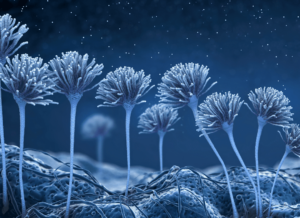 The many different substances that are emitted into the environment from mold can significantly alter the indoor air space and health of those occupants in this space. The substances that are created by mold and emitted into the air can include numerous things such as odorous compounds, mold spores, and even the toxic substances that are known as mycotoxins. As we talked about previously, these mycotoxins are created by microfungi that will impact a person’s health and cause neurotoxicity. When mycotoxins are produced from the various species of mold, the molecular structure of these toxins will vary widely, and this will lead to the effects that the mycotoxins have on a human’s health also vary in severity and symptoms.
The many different substances that are emitted into the environment from mold can significantly alter the indoor air space and health of those occupants in this space. The substances that are created by mold and emitted into the air can include numerous things such as odorous compounds, mold spores, and even the toxic substances that are known as mycotoxins. As we talked about previously, these mycotoxins are created by microfungi that will impact a person’s health and cause neurotoxicity. When mycotoxins are produced from the various species of mold, the molecular structure of these toxins will vary widely, and this will lead to the effects that the mycotoxins have on a human’s health also vary in severity and symptoms.
Although mycotoxins and their potential effects on the indoor air quality and occupant health can be scary, the reality is that most of the time acute toxicity is rare in individuals exposed to these mold toxins in their environment, according to Science Direct. Furthermore, they stated that toxicity due to mycotoxin exposure is almost always insidious, without any obvious signs of health effects in the short term.
Mycotoxins Symptoms
If you have ever been exposed to mold inside a confined indoor environment, then you may have experienced the various health symptoms that are provoked from exposure to mold and it’s toxins it produces into the air space. When it comes to a mold allergy or toxic mold syndrome illness, the symptoms that are elicited from an exposed individual will vary in specific ailments and overall severity. However, when it comes to symptoms that are produced from mycotoxin exposure that is created by mold inside of a home can include the following;
- Malaise
- Fatigue
- Cognitive impairment
- Watery, red eyes
- Skin rashes
- Sore throat
- Wheezing
- Sinusitis
- Runny or blocked nose
Mycotoxin Testing
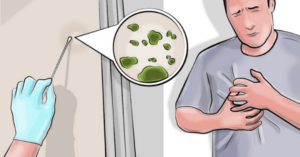 Do you think that you have mold present within the indoor air of your home, especially mycotoxins that are produced from this mold growth? If you do, then you may need to have a professional come in and test the indoor air quality of your indoor air space before adverse health effects start to take over your health. These indoor air quality tests can be conducted through mold testing kits that are sold directly to homeowners to conduct on their own. These tests will show whether mold is present in the air or that mold isn’t in the air, and if you determine that mold is in the air then you can send this test to a lab to conduct further testing that will detect which type of mold is in the home.
Do you think that you have mold present within the indoor air of your home, especially mycotoxins that are produced from this mold growth? If you do, then you may need to have a professional come in and test the indoor air quality of your indoor air space before adverse health effects start to take over your health. These indoor air quality tests can be conducted through mold testing kits that are sold directly to homeowners to conduct on their own. These tests will show whether mold is present in the air or that mold isn’t in the air, and if you determine that mold is in the air then you can send this test to a lab to conduct further testing that will detect which type of mold is in the home.
In addition to at-home lab testing, mold testing professionals can come to your home to conduct sampling and lab testing in the air of this indoor environment. If they find that mold is in the air space of the environment then further testing will be done to figure out the species of mold and whether or not they produced mycotoxins or other substances into the air.
Air Filter for Mold
Mold detection inside of your indoor environment will need to be remediated and mitigated to improve the indoor air quality and to help minimize health effects to occupants that are constantly exposed to this tainted indoor air space. When it comes to removing mold, particularly the mold spores that are produced in the air of a home. As we have learned previously, mold spores are one of the hazardous components released from mold inside an indoor space, along with mycotoxins. However, when it comes to removing mycotoxins from the air, very few air filters or air purification devices are capable of removing these toxins from the air due to their extremely small size in the air. Thus, when it comes to filtering out mold and it’s substances from the air, most air filters and purifiers are used only for the mitigation of mold spores in the indoor air.
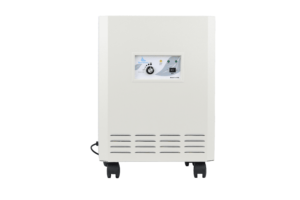 The EnviroKlenz Mobile UV Air System is a revolutionary air purifier that combines Advanced EnviroKlenz technology for toxic and noxious chemical and odor removal, along with HEPA filtration and ultraviolet germicidal radiation (UVC) to remove airborne particulates and allergens and inhibit the growth of captured microorganisms (like bacteria, mold spores, and viruses). The UVC lamps are strategically located in between the EnviroKlenz Air Cartridge and the HEPA filter because it allows for the UVC lamps to shine directly onto the HEPA filter where microorganisms and particulate matter accumulate when pushed through the EnviroKlenz UV Mobile Air System. These UVC lights will continuously shine on the collected organisms with high efficiency of kill and allow for the destruction of mold spores in the air that are present in the indoor air.
The EnviroKlenz Mobile UV Air System is a revolutionary air purifier that combines Advanced EnviroKlenz technology for toxic and noxious chemical and odor removal, along with HEPA filtration and ultraviolet germicidal radiation (UVC) to remove airborne particulates and allergens and inhibit the growth of captured microorganisms (like bacteria, mold spores, and viruses). The UVC lamps are strategically located in between the EnviroKlenz Air Cartridge and the HEPA filter because it allows for the UVC lamps to shine directly onto the HEPA filter where microorganisms and particulate matter accumulate when pushed through the EnviroKlenz UV Mobile Air System. These UVC lights will continuously shine on the collected organisms with high efficiency of kill and allow for the destruction of mold spores in the air that are present in the indoor air.
*EnviroKlenz Air Quality products will not work to remove mycotoxins from the air, rather they will help to remove the reproductive seeds called mold spores from the indoor air of a home or other personal indoor environment.
Article Sources:

UV Mobile Air System

✓ Patented earth mineral technology works to attack VOCs and break them down on a compound level
✓ No chemicals or masking agents
✓ Will not release any chemicals back into your environment
✓ UVC lamps are continuously shining on the collected organisms with high effeciency of kill and destruction
Comments
Post a Comment